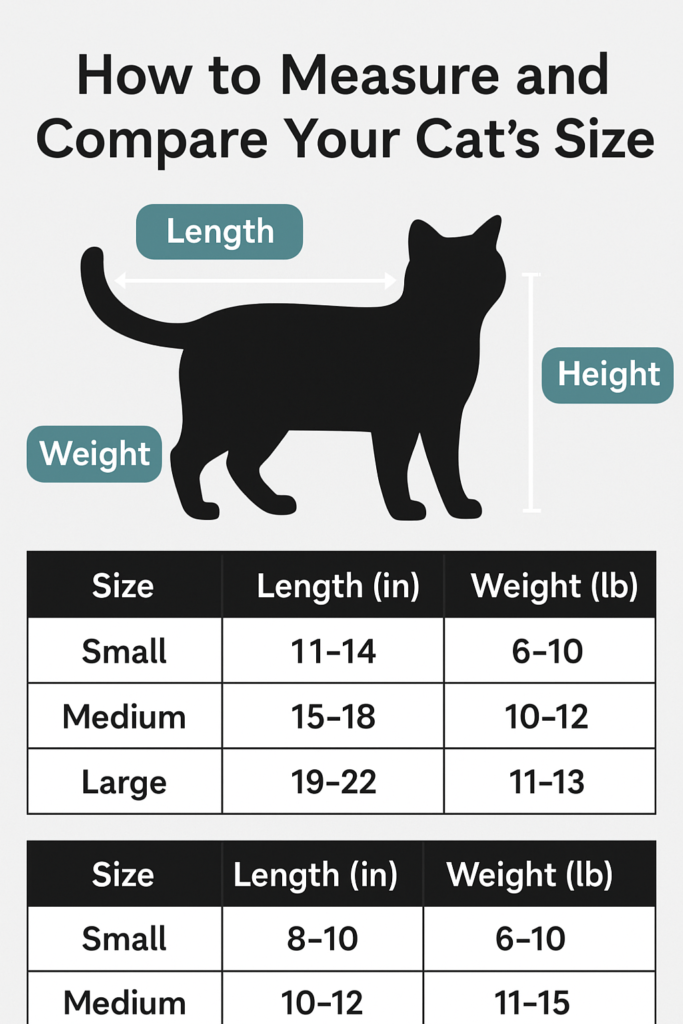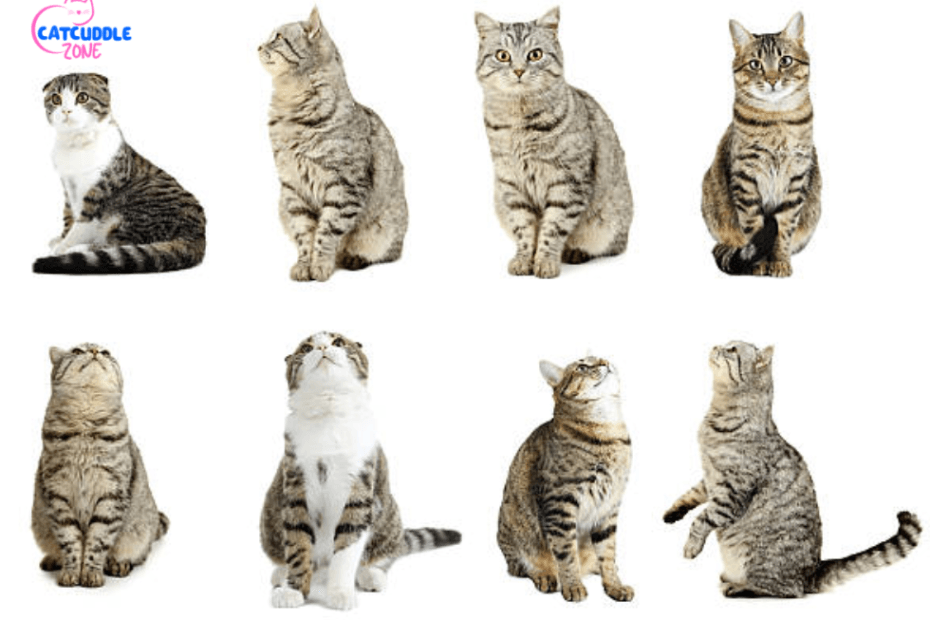Understanding your cat’s size and growth is more than just curiosity—it’s essential for your pet’s well-being. A cat size and growth chart helps you track your cat’s development through different life stages. Whether you have a kitten, adult, or senior feline, monitoring weight and size ensures they stay within a healthy cat weight range.
Different breeds grow at different rates, so knowing the breed-specific weight range can help prevent health problems. By using a chart, you can quickly identify any signs of underweight cat health or overweight cat risks. It’s a simple way to stay informed and support your cat’s health every step of the way.
Why Knowing Your Cat’s Size and Weight Matters
Your cat’s weight tells you a lot about its health. A healthy cat isn’t always skinny. And a fat cat isn’t always strong. Too much weight can cause heart disease, joint swelling, and fatty liver disease. Too little weight can lead to weak muscle mass and other problems.
Most indoor cats in the USA are overweight. Vets say pet owners often miss the early signs. That’s why cat health monitoring is so important. A regular check of your cat’s body can help stop problems early. A proper feeding schedule, along with good food and play, helps keep your cat in shape.
Cat Weight Chart by Age and Life Stage
Cats grow fast. Kittens gain weight quickly, while senior cats may lose muscle. This chart shows the average cat weight by age:
| Life Stage | Age Range | Average Weight (lbs) |
| Kitten | 0-6 months | 1 – 6 lbs |
| Junior | 7-12 months | 5 – 10 lbs |
| Adult | 1-6 years | 8 – 15 lbs |
| Mature | 7-10 years | 8 – 15 lbs |
| Senior | 11+ years | 7 – 13 lbs |
Older cats may need digestive support or high-protein diets to keep their muscle mass. Young kittens need nutrient-dense food for growth. Use this cat weight chart as a guide, but also check the body condition score.
Cat Size Chart by Breed
Different domestic cat breeds have different sizes. A Maine Coon is much larger than a Siamese. Here’s a look at breed-specific weight ranges:
| Breed | Size Classification | Weight Range (lbs) |
| Maine Coon | Large | 10 – 25 |
| Siamese | Small | 5 – 10 |
| Persian | Medium | 7 – 12 |
| Ragdoll | Large | 10 – 20 |
| American Shorthair | Medium | 8 – 15 |
Some cats naturally have fat pads, especially on their bellies. But too many fat pads can hide a serious issue. Knowing your cat’s cat size classification helps with food and portion control.
Healthy Cat Weight Ranges
Not every cat should weigh the same. A healthy cat weight depends on breed, age, and body shape. Here’s a guide to see where your cat falls:
| Cat Size | Healthy Weight Range |
| Small Breed | 5 – 10 lbs |
| Medium Breed | 8 – 15 lbs |
| Large Breed | 12 – 25 lbs |
You can also feel your cat’s ribs and check for a tummy tuck. A healthy cat should have a visible waist when seen from above. If it looks round all over, it may be overweight. Don’t guess—use a chart and observe carefully.
How to Measure and Compare Your Cat’s Size
To track size, you don’t need fancy tools. Just a scale and measuring tape. First, weigh yourself. Then weigh yourself holding the cat. Subtract to get your cat’s weight. For size, measure from the nose to the tail and around the belly.
Check your cat’s shape, too. Look for a tummy tuck near the back legs. Check for fat pads under the belly. Use the body condition score system. A score of 4–5 out of 9 means your cat is healthy. Lower or higher means there’s a problem.

Underweight or Overweight? Know the Signs
An underweight cat has visible ribs and thin legs. You may notice low energy or rough fur. This may need high-calorie cat food or cat weight gain supplements. Underweight cat health can worsen fast if ignored.
An overweight cat may be round with no visible waist. It may have difficulty jumping or cleaning itself. Overweight cat risks include heart disease, diabetes, and fatty liver disease. Obesity is a growing issue, but it can be prevented. You should be aware of the facts about cats before giving them such foods.
How to Maintain Your Cat’s Ideal Weight
To keep your cat at its ideal cat weight, start with a good cat nutrition and diet. Use portion control and stick to a feeding schedule. Don’t feed too many treats. Pick foods with natural ingredients, and if needed, add weight gainers or switch to low-carb cat food.
Daily play helps too. Use interactive toys for 10–15 minutes, two or three times a day. Daily play sessions improve movement and build muscle mass. Make sure your cat has space to climb or chase. Movement is the key to pet obesity prevention.
When to Consult a Veterinarian
If your cat suddenly gains or loses weight, don’t wait. It’s time for a veterinarian weight consultation. Your vet or veterinary nurse will check the body condition score and overall health. They may also do blood tests or suggest food changes.
Talk to your vet if your cat is acting tired, stops eating, or becomes very hungry without gaining weight. These could be signs of digestive problems or disease. Your vet will guide you with cat feeding guidelines and help track weight loss progress.
Final Thoughts: Keep Your Cat Fit and Healthy
Your cat depends on you. Watch its weight and body often. Know the signs of change. Use charts, measure often, and stay aware. Whether your cat is tiny or large, it deserves the best care.
The right food, fun play, and love can help avoid health issues. And always ask your vet if you’re unsure. A healthy cat is a happy one.
Related Products for Cat Weight and Size Management
Many tools help keep cats healthy. A digital scale is great for tracking weight. Use CBD cat treats for calm playtime. Add cat muscle support supplements if needed. Choose food with natural ingredients that fit your cat’s needs.
Also try puzzle feeders, interactive toys, and CBD for cats for wellness. There are even high-protein diets made for cats who need muscle gain. Ask your vet what’s best for your cat. Right tools make a big difference in your pet’s life.
Frequently Asked Questions
How do I tell how big my cat will get?
Check your cat’s breed, genetics, and growth rate—larger breeds grow bigger and longer than smaller ones.
How big is a 1 year old cat?
Most 1-year-old cats reach about 95% of their adult size, depending on breed and health.
How long does it take a cat to grow to full size?
Cats usually take 12 to 18 months to reach full size, though larger breeds may take up to 4 years.
At what age is a cat fully grown?
Most cats are fully grown by 12 to 18 months, but Maine Coons and similar breeds may mature slower.
